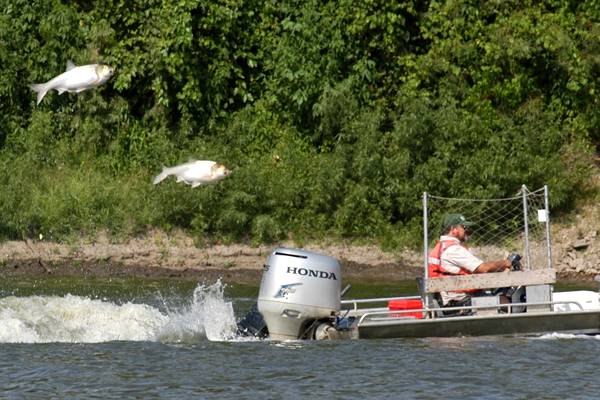New environmental DNA testing method greatly improves invasive Asian carp detection rate
Fish can’t leave footprints, but that doesn’t mean they don’t leave tracks. Anything living in the water parts ways with some genetic material from time to time.
Researchers from the University of Notre Dame have improved upon a technique to detect aquatic animals using trace environmental DNA or “eDNA”. They employed the methods in a study of Asian bighead carp, an invasive species presently threatening the Great Lakes. Their findings were published online in the scientific journal PLOS ONE.
“I started graduate school specifically to work on eDNA,” said Cameron Turner, a doctoral candidate at Notre Dame. “I had a background in genetics and saw this new method described by scientists in France.”
That method would serve as the foundation for Turner’s research into Asian carp. But going forward, he wanted to improve the method’s sensitivity while reducing its cost and subjectivity. He was excited by emerging research showing that eDNA might be used not only to determine the presence of a species, but to roughly estimate its abundance or proximity.
Asian carp eDNA detection has used polymerase chain reaction, or PCR, which works like a “DNA Xerox machine,” making millions of copies of genetic material, and then testing for the presence of a particular piece with fluorescent chemistry. The quantitative PCR, or qPCR, test developed by Turner and his team combines the replication and DNA testing steps, speeding up the process while reducing subjectivity and contamination risk. They also applied new methods to capture and purify eDNA from the water.
To evaluate their new methods, the researchers visited an experimental pond stocked with six bighead carp.
“We basically took the standard method and did side-by-side sampling with our new method,” Turner said.
Working over five days, the researchers gathered 48 water samples for each method. When they brought the samples back to the lab for testing, Turner said they expected “a pretty high number of detections for both methods.” Instead, the researchers found some surprising results.
“In our testing of this pond, the old methods never detected Asian carp DNA in any of the 48 samples that were collected,” Turner said. “That was really sort of surprising. We’ve used those methods in the field and have been able to detect Asian carp in places where Asian carp are not easily captured.”
On the other hand, the new procedure worked quite well, producing a 95 percent DNA detection rate. Turner said the vast discrepancy between the old and new methods could lie at any step in the process, be it the eDNA capture, purification or the genetic testing itself.
“We can’t say we know 100 percent why,” Turner said. “That’s the nature of research: There’s always more to be learned.”

Asian carp are fast-growing and aggressive, making them a threat to native Great Lakes species. (Credit: USGS)
However, the genetic testing, he said, exhibits the biggest difference between methods, as their qPCR test was 22 times more sensitive than the PCR test. Additionally, the new eDNA capture and purification method produced 5 times more Asian carp DNA from the water.
Confirming that the qPCR test vastly improved DNA detection was important, but not enough to convince the researchers that the method was totally superior to its predecessor.
“We needed to demonstrate that it was not just really sensitive, but also really specific,” Turner said. “In other words, that there was virtually no chance we would get a false positive from some other species of fish.”
This is where the qPCR test’s enhanced sensitivity demonstrated the importance of constant vigilance for contamination in eDNA laboratories. During early development of the qPCR test, they tested it on tissue from non-target fish such as goldfish. Unfortunately, the researchers found that nearly all of their tissue samples were contaminated by traces of Asian carp DNA. They were forced to restart their testing.
“There were many months of very frustrating work because we already worked in a lab with a lot of awareness, precautions and controls to prevent contamination,” he said. “We had to completely decontaminate our entire laboratory and divide it from one lab into two.”
Despite the temporary setback, new tissue samples and new laboratory procedures allowed Turner to confirm that the new qPCR test detects only Asian carp. This allow them to then compare old and new methods on the experimental pond, while including many controls to monitor for contamination. The new method is more sensitive than the previous PCR tests — and he says it’s a useful reminder of the risk that accompanies all sciences using trace amounts of DNA.
“One of the things we say is, sort of like Spider-Man learned from his uncle, with great power — to detect eDNA, comes great responsibility — to prevent contamination,” he said.



0 comments